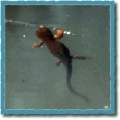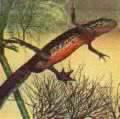Added 15 June 2000: last updated 27 January 2001 with thumbnail
images.
FROM NOVICE TO EXPERT.(2)
LEVEL 2: More challenging or time-consuming.
Axolotl (Ambystoma mexicanum)
 The
axolotl is a completely aquatic species that never loses its larval gills during
the normal course of its life. Originally the species' habitat was confined
to two lakes in Mexico, but these have been so reduced that little is known
of the wild population. Virtually all axolotls offered now have been bred in
captivity, having been kept in homes and laboratories for years around the world.
They make fairly hardy captives that require a simple tank of cold water, although
shelters are advisable if more than a pair are to be kept. They are good eaters.
The natural colour of these creatures is brown, but breeding over the generations
has produced plenty of the leucistic (white) examples, plus other colours. Perhaps
the only drawback to keeping axolotls is that their size (about 12") necessitates
a larger tank of water with the attendant demands of filtration, cleaning, etc.
A pair of axolotls will breed readily.
The
axolotl is a completely aquatic species that never loses its larval gills during
the normal course of its life. Originally the species' habitat was confined
to two lakes in Mexico, but these have been so reduced that little is known
of the wild population. Virtually all axolotls offered now have been bred in
captivity, having been kept in homes and laboratories for years around the world.
They make fairly hardy captives that require a simple tank of cold water, although
shelters are advisable if more than a pair are to be kept. They are good eaters.
The natural colour of these creatures is brown, but breeding over the generations
has produced plenty of the leucistic (white) examples, plus other colours. Perhaps
the only drawback to keeping axolotls is that their size (about 12") necessitates
a larger tank of water with the attendant demands of filtration, cleaning, etc.
A pair of axolotls will breed readily.
California Newt and relatives(Taricha spp)
 Taricha
torosa is a fairly hardy newt that grows to about 7", with a brown back
and tan yellow underside. It is somewhat flattened in appearance. The reason
that it is included in this section as opposed to Level 1 is that (a) it is
often overcollected (b) it is under other pressures in the wild, such as loss
of habitat (c) it requires a cooling period during the winter, not just for
breeding purposes but also for general health (Indiviglio).
Taricha
torosa is a fairly hardy newt that grows to about 7", with a brown back
and tan yellow underside. It is somewhat flattened in appearance. The reason
that it is included in this section as opposed to Level 1 is that (a) it is
often overcollected (b) it is under other pressures in the wild, such as loss
of habitat (c) it requires a cooling period during the winter, not just for
breeding purposes but also for general health (Indiviglio).


Crested Newt and relatives(Triturus spp)



Members of the Triturus genus are found in much of Europe, including
the British Isles. They favour cool water and apparently need more optimal care
than, for example, the Eastern Newt of North America. The aquatic phase lasts
from spring to early summer, after which the newts become terrestrial until
the winter hibernation period. A period of dormancy seems to be a prerequisite
for successful breeding. Care should be taken handling these newts as their
skin is very toxic. For these reasons, plus the fact that Triturus species
are restricted or protected in some parts of their range, I would consider this
to be a Level 2 animal rather than a starter species.
Marbled Newt (Triturus marmoratus)
 Much
of what has been said about the Crested Newt applies to the Marbled Newt. This
may be considered somewhat easier from a size point of view, however, as they
rarely grow longer than 6". They are very attractively patterned. Apart from
a brief aquatic breeding phase they are terrestrial. Indiviglio recommends winter
cooling and in addition shortening the photoperiod during this time to simulate
their seasons in the wild. Like the other Triturus species they are very
sensitive to water quality.
Much
of what has been said about the Crested Newt applies to the Marbled Newt. This
may be considered somewhat easier from a size point of view, however, as they
rarely grow longer than 6". They are very attractively patterned. Apart from
a brief aquatic breeding phase they are terrestrial. Indiviglio recommends winter
cooling and in addition shortening the photoperiod during this time to simulate
their seasons in the wild. Like the other Triturus species they are very
sensitive to water quality.
Spanish Ribbed Newt (Pleurodeles waltl)
 This
is the largest European newt at 12", and thus requires a somewhat larger tank
than most other newts. The rows of warts along its sides are actually protrusions
caused by its ribs, hence the name. Despite its size it does require a hiding
place and does not become as tame as some other newts. Indiviglio recommends
shallow water thickly planted with devil's ivy, with a shelter provided by a
clay flowerpot or piece of bark. This newt is almost entirely aquatic.
This
is the largest European newt at 12", and thus requires a somewhat larger tank
than most other newts. The rows of warts along its sides are actually protrusions
caused by its ribs, hence the name. Despite its size it does require a hiding
place and does not become as tame as some other newts. Indiviglio recommends
shallow water thickly planted with devil's ivy, with a shelter provided by a
clay flowerpot or piece of bark. This newt is almost entirely aquatic.
Green Salamander (Aneides aeneus)
 Attractive
plethodontid salamander instantly recognisable by its green coloration, the
Green Salamander is also known as the "climbing" or "tree" salamander owing
to its arboreal abilities, although its inclination is rather to climb into
crevices to avoid predators and dessication (Indiviglio). It is not large (3-5")
but requires a very moist environment with rock crevices to shelter in (ie some
sort of narrow cave-type shelter) in addition to the usual moss, and a secure
top on the tank. Small food items are a must. Eggs are laid on land and hatch
out terrestrial salamanders, thus avoiding the aquatic stage entirely.
Attractive
plethodontid salamander instantly recognisable by its green coloration, the
Green Salamander is also known as the "climbing" or "tree" salamander owing
to its arboreal abilities, although its inclination is rather to climb into
crevices to avoid predators and dessication (Indiviglio). It is not large (3-5")
but requires a very moist environment with rock crevices to shelter in (ie some
sort of narrow cave-type shelter) in addition to the usual moss, and a secure
top on the tank. Small food items are a must. Eggs are laid on land and hatch
out terrestrial salamanders, thus avoiding the aquatic stage entirely.
Dwarf Siren (Pseudobranchus striatus)
 The
sirens are an unusual family of salamanders from North America who are so distinct
that some have considered placing them in their own order (Indiviglio). Although
the other two members of the family are quite large (up to 2ft long), the dwarf
siren is much smaller (up to 8½" or less) and had fairly modest requirements.
Indiviglio recommends clean, shallow water with plenty of cover, ideally the
water hyacinth (genus Eichhornia) if possible but otherwise devil's ivy
as a good substitute. There is still much that we do not know about sirens,
particularly their mating habits and method of egg fertilisation, so here is
an opportunity for the amateur herpetologist to contribute towards scientific
knowledge.
The
sirens are an unusual family of salamanders from North America who are so distinct
that some have considered placing them in their own order (Indiviglio). Although
the other two members of the family are quite large (up to 2ft long), the dwarf
siren is much smaller (up to 8½" or less) and had fairly modest requirements.
Indiviglio recommends clean, shallow water with plenty of cover, ideally the
water hyacinth (genus Eichhornia) if possible but otherwise devil's ivy
as a good substitute. There is still much that we do not know about sirens,
particularly their mating habits and method of egg fertilisation, so here is
an opportunity for the amateur herpetologist to contribute towards scientific
knowledge.
Back |
Next |
Back to Amphibians |
Back to HomePage
 The
axolotl is a completely aquatic species that never loses its larval gills during
the normal course of its life. Originally the species' habitat was confined
to two lakes in Mexico, but these have been so reduced that little is known
of the wild population. Virtually all axolotls offered now have been bred in
captivity, having been kept in homes and laboratories for years around the world.
They make fairly hardy captives that require a simple tank of cold water, although
shelters are advisable if more than a pair are to be kept. They are good eaters.
The natural colour of these creatures is brown, but breeding over the generations
has produced plenty of the leucistic (white) examples, plus other colours. Perhaps
the only drawback to keeping axolotls is that their size (about 12") necessitates
a larger tank of water with the attendant demands of filtration, cleaning, etc.
A pair of axolotls will breed readily.
The
axolotl is a completely aquatic species that never loses its larval gills during
the normal course of its life. Originally the species' habitat was confined
to two lakes in Mexico, but these have been so reduced that little is known
of the wild population. Virtually all axolotls offered now have been bred in
captivity, having been kept in homes and laboratories for years around the world.
They make fairly hardy captives that require a simple tank of cold water, although
shelters are advisable if more than a pair are to be kept. They are good eaters.
The natural colour of these creatures is brown, but breeding over the generations
has produced plenty of the leucistic (white) examples, plus other colours. Perhaps
the only drawback to keeping axolotls is that their size (about 12") necessitates
a larger tank of water with the attendant demands of filtration, cleaning, etc.
A pair of axolotls will breed readily.





 Much
of what has been said about the Crested Newt applies to the Marbled Newt. This
may be considered somewhat easier from a size point of view, however, as they
rarely grow longer than 6". They are very attractively patterned. Apart from
a brief aquatic breeding phase they are terrestrial. Indiviglio recommends winter
cooling and in addition shortening the photoperiod during this time to simulate
their seasons in the wild. Like the other Triturus species they are very
sensitive to water quality.
Much
of what has been said about the Crested Newt applies to the Marbled Newt. This
may be considered somewhat easier from a size point of view, however, as they
rarely grow longer than 6". They are very attractively patterned. Apart from
a brief aquatic breeding phase they are terrestrial. Indiviglio recommends winter
cooling and in addition shortening the photoperiod during this time to simulate
their seasons in the wild. Like the other Triturus species they are very
sensitive to water quality.

